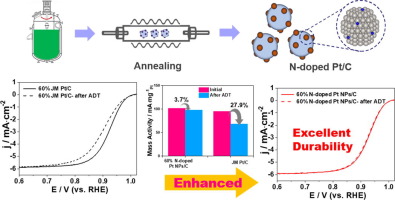Journal of Catalysis ( IF 7.3 ) Pub Date : 2020-01-09 , DOI: 10.1016/j.jcat.2019.12.025 Yunjie Xiong , Yunan Ma , Liangliang Zou , Shaobo Han , Hong Chen , Shuai Wang , Meng Gu , Yang Shen , Lipeng Zhang , Zhenhai Xia , Jun Li , Hui Yang

|
The availability of highly active and durable Pt based catalysts at a high metal loading is a prerequisite for practical applications in proton exchange membrane fuel cells (PEMFCs). Herein, we for the first time report the simple surfactant- and polymer-free synthesis of nonmetallic N doped Pt nanoparticles as electrocatalysts with an enhanced activity and excellent durability for oxygen reduction reaction (ORR) and such a synthetic procedure has been extended in a large-scale (>100 g/batch) for practical production already. X-ray diffraction and aberration-corrected transmission electron microscopy results clearly confirm that the doping of N within Pt lattice leads to the tensile strain in Pt nanoparticles. The tensile-strained Pt nanoparticles exhibit a negligible ORR activity decay by only 3.7% after a 20,000-cycle accelerated durability test (ADT) between 0.6 and 1.1 V/RHE, which places it among the most durable Pt-based catalysts reported for the ORR. While eliminating the strain effect, the activity degradation of the ORR on the Pt nanoparticles increases to 18.1%, close to that of commercial Pt/C catalyst (27.9%). Importantly, the tensile strain of N doped Pt nanoparticles is still remained after the ADT, assessing the structural stability of N-doped Pt nanoparticles. Theoretical calculations reveal that the N-doped Pt nanoparticles are chemically more stable than pristine ones due to Pt-N bonding effect, thus explaining well its excellent durability during the ORR. PEMFC integrated with as-prepared catalyst delivers a cell voltage of 0.65 V at the current density of 1.4 A·cm−2, satisfying the needs for vehicle use. The simple surfactant- and polymer-free approach presented here can be readily applied to other nonmetal doped Pt nanostructures and provides a promising potential for the practical applications in PEMFCs.
中文翻译:

N掺杂诱导的拉伸应变Pt纳米粒子可确保出色的氧还原反应耐久性
在高金属负载量下获得高活性和耐用的Pt基催化剂是质子交换膜燃料电池(PEMFC)实际应用的先决条件。在此,我们首次报道了非金属氮掺杂Pt纳米粒子作为无电催化剂的简单的无表面活性剂和聚合物的合成方法,该方法具有增强的活性和对氧还原反应(ORR)的优异耐久性,并且这种合成方法已在很大程度上得到了扩展规模(> 100克/批次)已投入实际生产。X射线衍射和像差校正的透射电子显微镜结果清楚地证实,Pt晶格中的N掺杂会导致Pt纳米颗粒中的拉伸应变。拉伸应变的Pt纳米粒子在20℃后,其ORR活性仅可忽略不计,下降了3.7%。000循环加速耐久性测试(ADT)在0.6至1.1 V / RHE之间,使其成为ORR报道的最耐用的Pt基催化剂之一。在消除应变影响的同时,ORR在Pt纳米颗粒上的活性下降增加到18.1%,接近于商用Pt / C催化剂(27.9%)。重要的是,在ADT之后,仍会保留N掺杂的Pt纳米颗粒的拉伸应变,从而评估N掺杂的Pt纳米颗粒的结构稳定性。理论计算表明,由于Pt-N的键合作用,N掺杂的Pt纳米颗粒在化学上比原始的更稳定,因此很好地说明了其在ORR期间的出色耐久性。集成了所制得催化剂的PEMFC在电流密度为1.4 A·cm时可提供0.65 V的电池电压 这使其成为ORR报道的最耐用的Pt基催化剂之一。在消除应变影响的同时,ORR在Pt纳米颗粒上的活性下降增加到18.1%,接近于商用Pt / C催化剂(27.9%)。重要的是,在ADT之后,仍会保留N掺杂的Pt纳米颗粒的拉伸应变,从而评估N掺杂的Pt纳米颗粒的结构稳定性。理论计算表明,由于Pt-N的键合作用,N掺杂的Pt纳米颗粒在化学上比原始的更稳定,因此很好地说明了其在ORR期间的出色耐久性。集成了所制得催化剂的PEMFC在电流密度为1.4 A·cm时可提供0.65 V的电池电压 这使其成为ORR报道的最耐用的Pt基催化剂之一。在消除应变影响的同时,ORR在Pt纳米颗粒上的活性下降增加到18.1%,接近于商用Pt / C催化剂(27.9%)。重要的是,在ADT之后,仍会保留N掺杂的Pt纳米颗粒的拉伸应变,从而评估N掺杂的Pt纳米颗粒的结构稳定性。理论计算表明,由于Pt-N的键合作用,N掺杂的Pt纳米颗粒在化学上比原始的更稳定,因此很好地说明了其在ORR期间的出色耐久性。集成了所制得催化剂的PEMFC在电流密度为1.4 A·cm时可提供0.65 V的电池电压 Pt纳米颗粒上ORR的活性下降增加到18.1%,接近商业Pt / C催化剂的活性下降(27.9%)。重要的是,在ADT之后,仍会保留N掺杂的Pt纳米颗粒的拉伸应变,从而评估N掺杂的Pt纳米颗粒的结构稳定性。理论计算表明,由于Pt-N的键合作用,N掺杂的Pt纳米颗粒在化学上比原始的更稳定,因此很好地说明了其在ORR期间的出色耐久性。集成了所制得催化剂的PEMFC在电流密度为1.4 A·cm时可提供0.65 V的电池电压 Pt纳米颗粒上ORR的活性下降增加到18.1%,接近商业Pt / C催化剂的活性下降(27.9%)。重要的是,在ADT之后,仍会保留N掺杂的Pt纳米颗粒的拉伸应变,从而评估N掺杂的Pt纳米颗粒的结构稳定性。理论计算表明,由于Pt-N的键合作用,N掺杂的Pt纳米颗粒在化学上比原始的更稳定,因此很好地说明了其在ORR期间的出色耐久性。集成了所制得催化剂的PEMFC在电流密度为1.4 A·cm时可提供0.65 V的电池电压 理论计算表明,由于Pt-N的键合作用,N掺杂的Pt纳米颗粒在化学上比原始的更稳定,因此很好地说明了其在ORR期间的出色耐久性。集成了所制得催化剂的PEMFC在电流密度为1.4 A·cm时可提供0.65 V的电池电压 理论计算表明,由于Pt-N的键合作用,N掺杂的Pt纳米颗粒在化学上比原始的更稳定,因此很好地说明了其在ORR期间的出色耐久性。集成了所制得催化剂的PEMFC在电流密度为1.4 A·cm时可提供0.65 V的电池电压−2,满足车辆使用需求。本文介绍的简单的无表面活性剂和无聚合物方法可轻松应用于其他非金属掺杂的Pt纳米结构,并为PEMFC的实际应用提供了有希望的潜力。


























 京公网安备 11010802027423号
京公网安备 11010802027423号